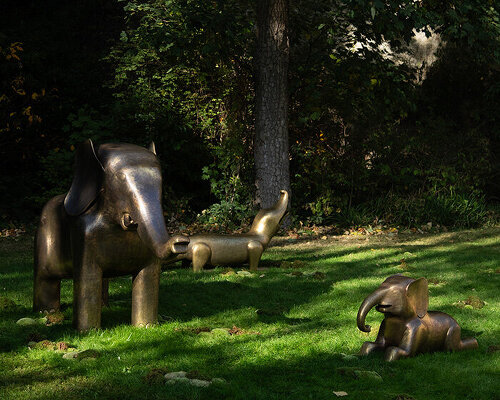vikram goyal’s soul garden at design miami/paris 2025
In the lush gardens of L’Hôtel de Maisons, once the Parisian home of Karl Lagerfeld, designer Vikram Goyal unveils The Soul Garden, an installation that transforms India’s ancient animal fables into a living, multisensory landscape. Presented by The Future Perfect for Design Miami/Paris 2025, the project, on view from October 21st to 26th, 2025, bridges sculpture, craft, design, and olfactory art in collaboration with Berlin-based artist Sissel Tolaas, who translates the invisible language of scent into a medium of storytelling and emotion.
all images by Alfredo Piola, unless stated otherwise
a sanctuary of spirit, memory, and craft
The Soul Garden reimagines India’s timeless reverence for animals as vessels of wisdom and guardianship. The installation gathers five sculpted creatures, the Tiger (Vyaghra), the Elephant and Baby Elephant (Gaja and Karabha), the Tortoise (Kurma), and the Crocodile (Nakra), crafted through the New Delhi-based designer Vikram Goyal’s signature repoussé and hollowed joinery metal techniques. ‘In India, animals are more than instinct, they are sacred, sentient, divine. Many embody essential virtues – strength, wisdom, loyalty, tranquillity,’ notes Goyal. ‘This recognition of their spiritual equivalence has led to their protection and veneration for centuries.’
Each animal encapsulates a moral dimension drawn from the Panchatantra, a 2,000-year-old collection of Sanskrit fables that uses animal protagonists to teach lessons in empathy, prudence, and coexistence. Within the sculptures, hidden repoussé panels reveal miniature narrative scenes inspired by these tales. Collectively, they form a contemporary bestiary, one that fuses India’s sculptural heritage with the animaliers of 20th-century Europe, such as François-Xavier Lalanne and Rembrandt Bugatti.
Vikram Goyal unveils The Soul Garden in the lush gardens of L’Hôtel de Maisons
Sissel Tolaas translates the animal world through scent
For Goyal, scent became the natural language of the animal world and the essential dimension of The Soul Garden. To realize this idea, he invited Sissel Tolaas, renowned for her pioneering work in olfactory research and art, to create a smellscape that would bring emotional depth to the installation.
‘For animals, smell is their primary language; it’s how they find food, recognise kin, warn of danger and even express emotion,’ says Goyal. ‘Scent is a story, and in order to be true to the intelligence of animals, The Soul Garden needed to speak in this invisible but powerful register. That’s why I turned to Sissel Tolaas.’
Tolaas, who describes smell molecules as ‘the alphabet of the air,’ visited Goyal’s studio in New Delhi to collect molecular samples during the metalworking process. She also recorded scent profiles from real animal habitats and interactions, synthesizing each species’ olfactory signature. Using a combination of nanotechnological and analog diffusion devices embedded in the sculptures and surrounding grasses, these molecular blends subtly fill the garden with layered fragrances. ‘To engage with The Soul Garden through smell is to unlock an encounter infused with emotion, play and vulnerability,’ shares Tolaas. ‘And without an emotional reaction, there can be no action.’
an installation that transforms India’s ancient animal fables into a living, multisensory landscape
Between myth and memory
Visitors of the Soul Garden are encouraged to sit among the sculptures, read, or simply breathe in the layered scents. Each evening at 5 pm, students from Cours Florent, Paris’s renowned performing arts school, will perform readings from the Panchatantra, animating its fables of wit and morality, the Lion and the Hare, the Monkey and the Crocodile, the Tortoise and the Birds, with renewed voice and presence. As a symbolic gesture, talismans will be offered to visitors, inviting them to become caretakers of the animals, acknowledging a shared duty of guardianship toward both mythic and living beings.
Through the fusion of sculpture, scent, and story, The Soul Garden emerges as a fable for the present moment—an appeal for empathy, ecology, and coexistence amid an age of disconnection. ‘It reinterprets Indian animal fables not as relics of the past but as blueprints for future thinking – about empathy, ecology, and coexistence,’ says Goyal. ‘By entering this living fable, each visitor leaves not only with a story, but a renewed role in the wider web of life.’
presented by The Future Perfect for Design Miami/Paris 2025
on view from October 21st to 26th | image by Ali Monis Naqvi
bringing together sculpture, craft, design, and olfactory art | image by Ali Monis Naqvi
reimagining India’s timeless reverence for animals as vessels of wisdom and guardianship | image by Ali Monis Naqvi
the installation gathers five sculpted creatures | image by Ali Monis Naqvi
each animal encapsulates a moral dimension drawn from the Panchatantra | image by Ali Monis Naqvi
the animal sculptures are crafted through Vikram Goyal’s signature techniques | image by Ali Monis Naqvi
fusing India’s sculptural heritage with the animaliers of 20th-century Europe | image by Ali Monis Naqvi
visitors of the Soul Garden are encouraged to sit among the sculptures | image by Ali Monis Naqvi
project info:
name: The Soul Garden | @vikramgoyalstudio
designer: Vikram Goyal Studio | @vikramgoyalstudio
location: L’Hôtel de Maisons, Rue de l’Université, Paris, France
event: Design Miami/Paris 2025
collaborator: Sissel Tolaas (olfactory artist) | @sssl_berlin
presented by: The Future Perfect
dates: October 21st–26th, 2025
photographer: Alfredo Piola | @alfredo_piola, Ali Monis Naqvi | @alimonisnaqvi
The post vikram goyal turns india’s ancient animal fables into a scented landscape in paris appeared first on designboom | architecture & design magazine.

